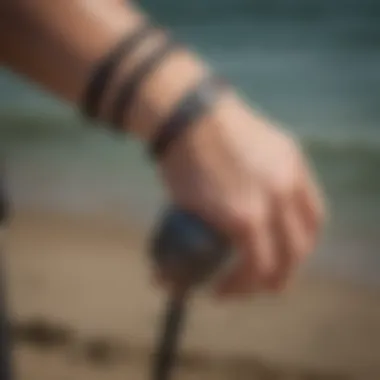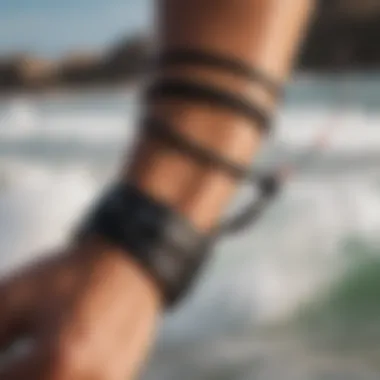The Crucial Role of Wrist Leashes in Kitesurfing and Kiteboarding Explained


Equipment Reviews
When delving into the world of kiteboarding and kitesurfing, understanding the equipment is paramount. Let's start our exploration by reviewing the essential gear – kites, boards, and accessories that play a pivotal role in these exhilarating water sports.
- Kites: Today, the market is teeming with a plethora of kite models, each boasting unique features and performance capabilities. From hybrid shapes to delta shapes, materials range from durable ripstop nylon to lightweight polyester. Brands renowned for their quality craftsmanship include names like Cabrinha, Slingshot, and Naish, setting the standards for innovation and reliability.
- Boards: Kiteboarding enthusiasts have the luxury of choosing from various board types, such as twintips and directional boards, tailored to different riding styles. Twintips offer versatility, perfect for freestyle tricks and jumping, while directional boards excel in waves, providing stability and control. Design elements like concave contours and rocker profiles significantly influence a board's maneuverability and performance on the water.
- Accessories: In the realm of kiteboarding, the devil is indeed in the details. Harnesses, lines, pumps, and safety gear serve as the backbone of a rider's safety and comfort. Harnesses come in waist and seat options, each catering to individual preferences for control and support. Quality lines made from Dyneema ensure strength and minimal stretch, crucial for responsive kite control. Pump designs have evolved to reduce inflation time, enhancing convenience before hitting the waves. Safety gear like helmets, impact vests, and depower systems are non-negotiable additions, reinforcing the importance of preparedness and protection.
Let's now pivot our focus on the vital component that ties the kitesurfer to their kite – the wrist leash.
Introduction
Kitesurfing and kiteboarding, exhilarating water sports that blend wind power with adrenaline, necessitate meticulous attention to safety equipment. Among the critical gear used in these electrifying pursuits are wrist leashes. In this comprehensive guide, we delve into the significance of wrist leashes in the context of kitesurfing and kiteboarding. These essential accessories play a pivotal role in safeguarding enthusiasts, enhancing control, and ensuring a seamless experience on the water.
Defining Wrist Leashes
Understanding the anatomy and functionality of wrist leashes is fundamental in harnessing their full potential. Essentially, wrist leashes are durable tethers designed to connect the rider to the kite, serving as a crucial link between the two elements. By securely fastening the rider's wrist to the kite control bar, these leashes act as a safety mechanism, preventing the kite from drifting away in case of a fall or loss of grip. This primary function underscores the paramount importance of wrist leashes in kitesurfing and kiteboarding.
Importance of Wrist Leashes in Kitesurfing and Kiteboarding
The importance of wrist leashes in kitesurfing and kiteboarding cannot be overstated. These vital components not only serve as a safety lifeline but also enable riders to maneuver their kites with precision and finesse. In the dynamic environment of kite sports, where wind dynamics can change rapidly, wrist leashes offer a sense of security, empowering athletes to push their limits while mitigating risks. By exploring the multifaceted role that wrist leashes play in enhancing the overall kitesurfing and kiteboarding experience, enthusiasts can better appreciate the value of this seemingly modest accessory.
Purpose of the Article
Through this meticulous exploration of wrist leashes in kitesurfing and kiteboarding, our primary aim is to equip enthusiasts with comprehensive knowledge that transcends the superficial understanding of these essential tools. By unraveling the nuances of wrist leash design, functionality, and maintenance, we seek to elevate the reader's awareness of the critical role that this gear plays in ensuring safety and performance. Whether you're a seasoned kitesurfer or a novice embarking on your first adventure, this article aims to serve as a beacon of insights and expertise, illuminating the path to a safer, more rewarding kitesurfing and kiteboarding experience.
Understanding Wrist Leashes


Understanding wrist leashes is paramount in the realm of kitesurfing and kiteboarding. These vital components serve as a critical link between the rider and the kite, ensuring safety, control, and efficiency during water sports activities. A meticulous examination of wrist leashes unravels the intricate details that dictate their performance and impact on the overall kitesurfing experience. By delving into the components, types, and materials of wrist leashes, enthusiasts can elevate their understanding of this essential gear and make informed decisions for their sporting endeavors.
Components of Wrist Leashes
Wrist leashes consist of several key components that work in harmony to provide stability and security while on the water. These components include but are not limited to the leash itself, the attachment point to the harness, the quick-release mechanism, and any additional safety features integrated into the design. Each element plays a crucial role in ensuring the effectiveness and reliability of the wrist leash, making it imperative for riders to understand the function and importance of these components for their safety and control.
Types of Wrist Leashes
Wrist leashes come in various types, each tailored to meet specific preferences and requirements of riders. The three primary types of wrist leashes commonly used in kitesurfing and kiteboarding are coiled leashes, straight leashes, and bungee leashes. coiled leashes are characterized by their retractable design, offering flexibility and preventing tangling during maneuvers. Straight leashes provide a direct connection between the rider and the kite, allowing for precise control and responsiveness. Bungee leashes incorporate an elastic component, absorbing shock and reducing strain on the rider during sudden movements. Understanding the nuances of each type empowers enthusiasts to select the most suitable option based on their riding style and individual needs.
Coiled Leashes
Coiled leashes excel in providing freedom of movement while maintaining a secure connection to the kite. The inherent coil design reduces drag in the water and prevents entanglement with other equipment, facilitating seamless navigation on the waves. This unique feature sets coiled leashes apart as a popular choice among riders seeking enhanced maneuverability and safety in challenging conditions.
Straight Leashes
Straight leashes offer direct responsiveness and simplicity in their design, appealing to riders who prioritize precision and immediate feedback from their kite. The straightforward construction of straight leashes ensures a reliable connection without unnecessary slack, allowing for quick adjustments and seamless control during kitesurfing or kiteboarding sessions. While their straightforward nature enhances control, some riders may find the lack of flexibility a potential limitation in certain dynamic scenarios.
Bungee Leashes
Bungee leashes leverage elastic properties to provide shock absorption and a degree of give during abrupt movements on the water. This elasticity reduces strain on the rider's wrists and harness attachment point, enhancing comfort and minimizing the risk of injury during high-impact situations. The unique feature of bungee leashes adds a layer of safety and adaptability to the kitesurfing experience, particularly for riders who engage in freestyle tricks or handle powerful kite movements.
Materials Used in Wrist Leashes
Manufacturers utilize an array of materials to construct wrist leashes, each with distinct properties that influence the leash's durability, flexibility, and overall performance in water sports. Common materials employed in wrist leash production include durable nylon for the leash body, corrosion-resistant stainless steel for attachment components, and robust neoprene for added comfort at contact points. An in-depth understanding of these materials empowers riders to discern the quality and suitability of wrist leashes for their intended use, ensuring optimal performance and longevity in challenging kitesurfing and kiteboarding conditions.
Benefits of Wrist Leashes


In the realm of kitesurfing and kiteboarding, the utilization of wrist leashes plays a pivotal role in enhancing the overall safety and control of the activities involved. These wrist leashes are not mere accessories but rather indispensable tools that provide a layer of security and reassurance to enthusiasts engaging in these exhilarating water sports.
Enhanced Safety Measures
Wrist leashes are designed to serve as a crucial safety mechanism, ensuring that the kite remains tethered to the surfer at all times. In the event of a fall or loss of control, the leash prevents the kite from drifting away, thereby reducing the risk of accidents and potential injuries. This safety feature offers peace of mind to riders, allowing them to focus on perfecting their techniques without worrying about losing their equipment.
Improved Control and Maneuverability
Apart from safety, wrist leashes contribute significantly to the overall control and maneuverability of the kite while kitesurfing or kiteboarding. By maintaining a direct connection between the rider and the kite, these leashes enable smooth and precise handling, facilitating swift turns and maneuvers with minimal effort. This enhanced control not only enhances the performance of the surfer but also adds a layer of confidence, enabling them to push their limits and explore new tricks and techniques.
Convenience and Comfort
In addition to safety and control, wrist leashes also offer a level of convenience and comfort to kitesurfers and kiteboarders. With the kite securely attached to their wrist, riders can enjoy a hands-free experience, allowing them to focus on their techniques and navigation without unnecessary distractions. The lightweight and ergonomic design of modern wrist leashes ensures that they are comfortable to wear for extended periods, providing a seamless and uninterrupted kitesurfing or kiteboarding session.
Choosing the Right Wrist Leash
Factors to Consider
Length and Stretch
Length and stretch refer to the extension capability of the leash while maintaining its durability. Longer leashes allow more freedom of movement but can increase the risk of entanglement, whereas shorter leashes provide better control but limit motion. The optimal length and stretch balance is crucial to enhance maneuverability while minimizing hazards. To achieve this equilibrium, select a leash that offers adequate length for maneuvering yet minimal stretch to avoid sudden jerks.
Attachment Mechanism
The attachment mechanism dictates how the leash secures the rider's wrist to the kite. A reliable attachment ensures the leash stays connected in all conditions, guaranteeing rider safety. Common attachment methods include Velcro straps, clips, and quick-release systems. Opt for a mechanism that balances firm fixation with easy detachment in emergencies, allowing seamless operation without compromising safety.


Durability
Durability is a key determinant of the leash's longevity and performance. A durable wrist leash can withstand harsh conditions such as strong winds, UV exposure, and frequent use without compromising its functionality. Look for materials like high-quality neoprene, nylon, or PVC coatings that offer robust protection against wear and tear. Prioritize durability to ensure your wrist leash remains reliable in challenging environments.
Maintenance Tips
Regularly inspect the leash for signs of wear, fraying, or weakening components that may jeopardize its efficacy. Clean the leash with fresh water after each use to remove salt and sand residues that can deteriorate its materials over time. Store the leash in a cool, dry place away from direct sunlight to prevent premature degradation. By adhering to these maintenance practices, you can maximize the longevity and functionality of your wrist leash, ensuring a safe and enjoyable kitesurfing experience.
Safety Guidelines and Best Practices
In the realm of kitesurfing and kiteboarding, the observance of safety guidelines and best practices stands as an absolute cornerstone for practitioners to avert untoward incidents and enhance overall enjoyment. These guidelines are meticulously crafted to instill discipline and preparedness in athletes, ensuring their well-being amidst the dynamic forces of wind and water. By adhering closely to these protocols, individuals can safeguard themselves from potential dangers and foster a culture of responsibility within the kitesurfing community.
Proper Attachment and Adjustment
In kitesurfing, the correct attachment and adjustment of wrist leashes secure a rider's connection to the kite, empowering them with freedom and restraint in equal measure. Ensuring that the leash is affixed snugly to the wrist eliminates the risk of detachment during vigorous maneuvers, maintaining continuous control over the kite. Proper adjustment, complemented by periodic reassessment, guarantees optimal functionality and minimizes malfunction risks, underscoring the pivotal role of meticulous attention to detail in kitesurfing safety protocols.
Emergency Situations
Emergency situations in kitesurfing require swift and judicious action to avert potential harm and resolve precarious scenarios effectively. Being well-versed in emergency protocols equips individuals with the competence to navigate challenging circumstances with clarity and swiftness, mitigating risks and upholding safety standards. Practitioners must acquaint themselves with contingency procedures, ranging from quick release mechanisms to signal for assistance, enabling them to react decisively in exigent situations and ultimately safeguard their well-being and that of others.
Conclusion
In the realm of kiteboarding and kitesurfing, the significance of wrist leashes cannot be overstated. They act as a pivotal component in ensuring the safety, control, and overall experience of riders engaging in these high-intensity water sports. Wrist leashes serve as a crucial link between the kiter and the kite, providing a level of security that is paramount in unpredictable marine environments. By maintaining a firm grip on the control bar through the wrist leash, riders can swiftly respond to changing wind conditions and navigate challenging maneuvers with enhanced precision.
The benefits of utilizing wrist leashes extend beyond safety alone. They contribute substantially to the overall control and maneuverability that riders can exert over their kites. The secure connection established by the wrist leash empowers kiters to execute intricate tricks and turns with confidence, pushing the boundaries of their skills while maintaining a sense of security. Additionally, the convenience and comfort offered by wrist leashes enable riders to focus purely on their performance without distractions or concerns about losing control of their equipment. Furthermore, durability, length, and attachment mechanisms play a critical role in selecting the right wrist leash. Ensuring that the wrist leash is of optimal length and stretch can enhance the rider's range of motion without compromising safety. The attachment mechanism should be robust and reliable, offering a secure connection between the rider and the kite. Additionally, prioritizing a durable wrist leash constructed from high-quality materials enhances longevity and overall performance, underscoring the importance of choosing wisely.
Summary of Key Points
- Wrist leashes are indispensable in kitesurfing and kiteboarding, providing essential safety and control features for riders.
- The secure connection facilitated by wrist leashes enhances maneuverability and allows riders to perform challenging tricks with confidence.
- Selecting the right wrist leash involves considering factors such as length, stretch, attachment mechanism, and durability to optimize performance and safety during rides.
Final Thoughts
Wrapping up our exploration of the importance of wrist leashes in kitesurfing and kiteboarding, it is evident that these seemingly simple components play a fundamental role in elevating the entire riding experience. Beyond being a mere accessory, wrist leashes embody the essence of safety, control, and comfort, acting as the unseen guardians that enable riders to conquer the waves with finesse. As riders gear up for their next adrenaline-fueled session, a reliable wrist leash will undoubtedly be their steadfast companion, ensuring not only their safety but also unlocking the full potential of their performance on the water.







